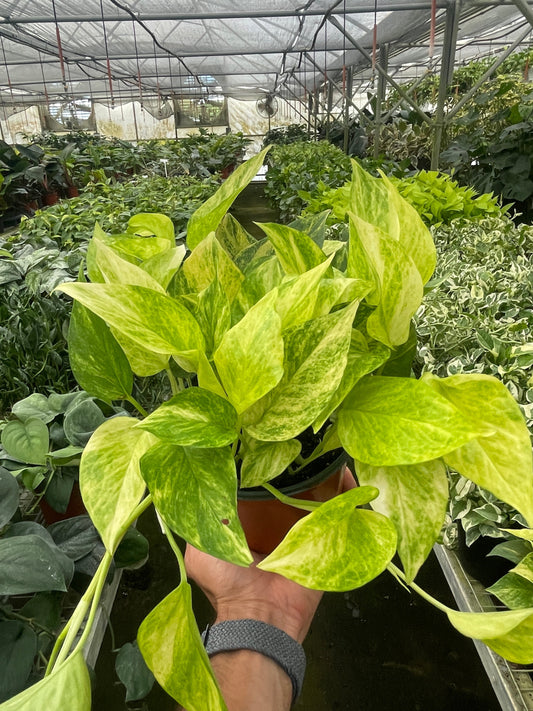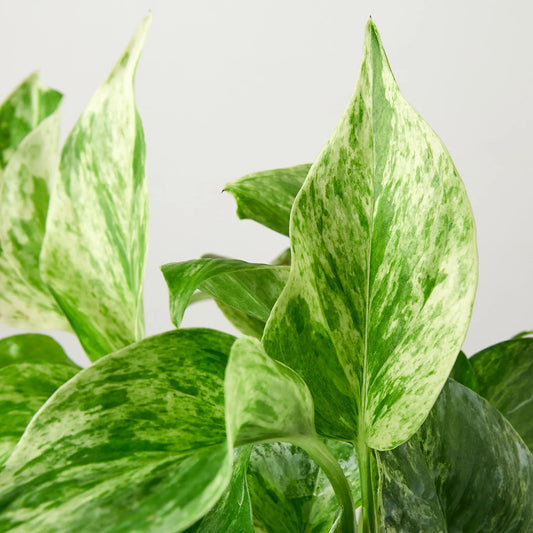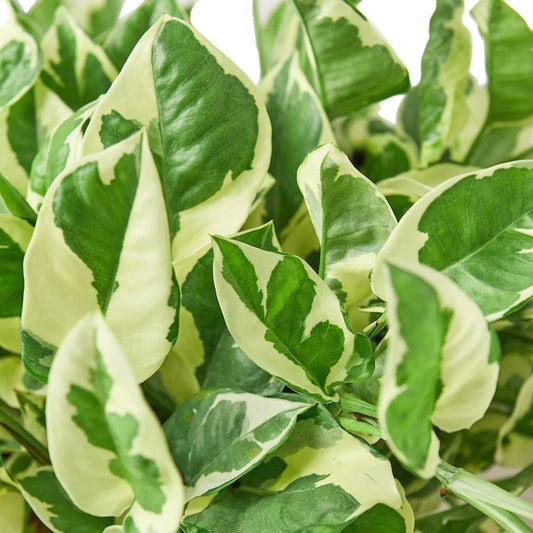How To Prune a Areca Palm (The RIGHT Way)
Cafe Planta Team
Pruning an Areca Palm might seem a little intimidating at first glance, but with the right know-how, it can become a satisfying part of your plant care routine. These graceful plants can bring a tropical feel to any space, but they do need a little attention now and then to keep them looking their best.
We'll walk through the why, when, and how of pruning your Areca Palm, along with some handy tips and tricks to help you along the way. By the end of this read, you'll feel confident enough to give your plant the care it deserves.
Why Prune an Areca Palm?
First things first, why should you prune your Areca Palm? Well, pruning isn’t just about aesthetics, although that’s definitely a plus. Regular pruning helps maintain the health of the plant by removing dead or damaged leaves, allowing the plant to focus its energy on new growth. It can also prevent diseases from spreading and discourage pests that might be drawn to decaying material.
Think of pruning like a regular haircut. Just as a trim can promote healthy hair growth, pruning can encourage your Areca Palm to grow fuller and more vibrant. Dead leaves can be a drain on the plant’s resources, so removing them gives your palm the best chance to thrive.
Moreover, pruning helps manage the size of your plant. Areca Palms can grow quite large if left unchecked, so pruning keeps them at a manageable size for your space. Whether you're dealing with a corner of your living room or a small patio, a well-pruned Areca Palm can make all the difference.
When to Prune Your Areca Palm
Timing is everything, as they say, and this holds true for pruning your Areca Palm. The best time to prune is during the plant’s active growing season, typically in late spring or early summer. During this time, the plant is more resilient and can recover quickly from the pruning process.
While you can remove dead or diseased leaves anytime you spot them, try to reserve major pruning sessions for the growing season. This gives the plant a chance to heal and grow back stronger. Remember, patience is key. If you notice a few brown tips on the leaves, resist the urge to snip them immediately. Sometimes, it’s better to let the plant do its thing.
Over-pruning can stress your plant, so aim for a balanced approach. If you're unsure, it's better to prune less and observe how your plant responds. You can always return for a second round if needed. And if you're wondering if there's a specific day that's best, don't worry too much. Just avoid pruning when your plant seems stressed or is adjusting to a new environment.
Gathering Your Tools
Before you start snipping away, make sure you have the right tools for the job. Using the proper equipment not only makes the process easier but also helps prevent damage to your plant. Here’s a quick checklist of what you’ll need:
- Sharp Pruning Shears: A good pair of pruning shears is essential. Dull blades can tear the leaves instead of cutting them cleanly, which can lead to damage.
- Gloves: While not strictly necessary, gloves can protect your hands from dirt and any potential irritants on the plant.
- Disinfectant: It's a good idea to disinfect your shears before and after use to prevent the spread of disease. A simple solution of one part bleach to nine parts water works well.
Having these tools on hand makes the process smoother and ensures that your plant stays healthy. Plus, there's something quite satisfying about being fully prepared for the task at hand. Now that you've got your tools ready, it's time to move on to the actual pruning process.
Step-by-Step Guide to Pruning
With your tools assembled and your plant ready, you’re all set to start pruning. Here’s a detailed guide on how to prune your Areca Palm effectively:
1. Inspect the Plant
Before making any cuts, take a moment to thoroughly inspect your plant. Look for any dead, yellowing, or damaged leaves. These are the ones you’ll want to focus on removing. Also, check for any signs of pests or disease, as these can influence your pruning strategy.
2. Cut Dead or Yellowing Leaves
Using your sharp pruning shears, cut dead or yellowing leaves at the base, close to the main stem. Be careful not to cut into the stem itself, as this can harm the plant. If you’re unsure whether a leaf needs removing, err on the side of caution and leave it for your next pruning session.
3. Trim Brown Tips
Brown tips are a common issue with Areca Palms and can result from various factors like underwatering, overwatering, or low humidity. Trim the brown tips carefully, following the natural curve of the leaf to maintain its shape. This keeps the plant looking tidy without over-pruning.
4. Address Pests and Diseases
If you notice signs of pests or disease, such as small holes in the leaves or unusual spots, it’s crucial to address these issues. Pruning away affected leaves can help, but you might also need to treat your plant with an appropriate pesticide or fungicide. Always follow the instructions carefully to avoid harming your plant.
With these steps, your Areca Palm should be looking much healthier and more vibrant. Remember, the goal is to help your plant thrive, so always prune with care and consideration.
Common Pruning Mistakes to Avoid
While pruning is generally straightforward, there are a few common pitfalls that plant people sometimes encounter. Here’s how to avoid them:
- Over-Pruning: It’s easy to get carried away, especially if your plant has a lot of dead leaves. However, over-pruning can stress your plant and lead to decreased growth. Only remove what’s necessary.
- Using Dull Tools: Dull shears can crush and damage leaves instead of providing a clean cut. Always keep your tools sharp and well-maintained.
- Neglecting Tool Hygiene: Failing to disinfect your tools can spread disease between plants. Make it a habit to clean your shears before and after each use.
Avoiding these mistakes will help ensure that your Areca Palm stays healthy and continues to bring a touch of the tropics into your home. Remember, it’s all about balance and observation.
Caring for Your Areca Palm Post-Pruning
After you’ve finished pruning, it’s important to give your Areca Palm a little extra care to help it recover and thrive. Here are some tips to keep in mind:
1. Watering
Water your plant thoroughly, but make sure it has proper drainage to prevent root rot. Areca Palms prefer consistently moist soil, so check the top inch of the soil regularly and water when it feels dry.
2. Light Conditions
Areca Palms thrive in bright, indirect light. After pruning, make sure your plant is getting adequate light, but avoid placing it in direct sunlight, which can scorch the leaves.
3. Humidity
These palms love humidity, so consider misting the leaves or placing a humidifier nearby if your home is particularly dry. This can also help prevent those pesky brown tips from appearing.
With these care tips, your Areca Palm should bounce back from its pruning session, looking healthier and happier than ever.
Designing Your Space with Areca Palms
Areca Palms aren’t just about function—they’re also about form! Their elegant fronds can add a lovely touch to any room, creating a sense of calm and sophistication. If you’re looking to integrate these palms into your decor, here are some ideas:
- Corner Statement: Place a tall Areca Palm in a corner to add height and interest. This works well in living rooms or offices where you want to draw the eye upward.
- Grouping with Other Plants: Areca Palms play well with others. Consider grouping them with smaller plants or succulents to create a lush, layered look.
- Outdoor Oasis: In warmer climates, these palms can thrive outdoors. Use them to create a tropical vibe on a patio or balcony.
Whether you’re going for a minimalistic look or a jungle-inspired theme, Areca Palms can be a versatile and beautiful addition to your home.
Dealing with Pests and Fungal Issues
Like all plants, Areca Palms can sometimes fall victim to pests and fungal issues. Here’s how to handle these common problems effectively:
1. Common Pests
Spider mites and mealybugs are the usual suspects when it comes to pest problems. Regularly inspect your plant and wipe down the leaves with a damp cloth to keep these pests at bay. For more persistent infestations, consider using insecticidal soap or neem oil.
2. Fungal Issues
Overwatering can lead to root rot and fungal infections. Ensure your pot has proper drainage and avoid letting the plant sit in water. If you notice any signs of fungus, such as black spots on the leaves, trim away affected areas and adjust your watering schedule.
By staying vigilant and proactive, you can keep your Areca Palm healthy and thriving, free from pests and fungal issues.
Choosing the Right Pot and Soil
Last but not least, the right pot and soil can make a world of difference for your Areca Palm. Here’s what to consider:
- Pot Size: Choose a pot that allows room for growth but isn’t too large. A pot that’s too big can hold excess water, leading to root rot.
- Drainage: Good drainage is crucial. Make sure your pot has drainage holes and consider using a saucer to catch excess water.
- Soil Type: Use a well-draining potting mix, ideally one that’s formulated for palms. You can also mix regular potting soil with sand or perlite to improve drainage.
With the right pot and soil, your Areca Palm will have the best foundation for growth, ensuring it stays healthy and vibrant for years to come.
Final Thoughts
Pruning your Areca Palm doesn’t have to be a daunting task. With a little care and attention, you can keep your plant looking its best and thriving in your space. Remember, the key is to observe your plant’s needs and adjust your care routine accordingly.
At Cafe Planta, we're passionate about helping you care for your plants. Whether you need advice on pruning or are looking for new additions to your plant family, we're here to help. Feel free to email us or reach out on Instagram. We're excited to share our love of plants with you and help you create a beautiful, thriving plant collection in your home.



















